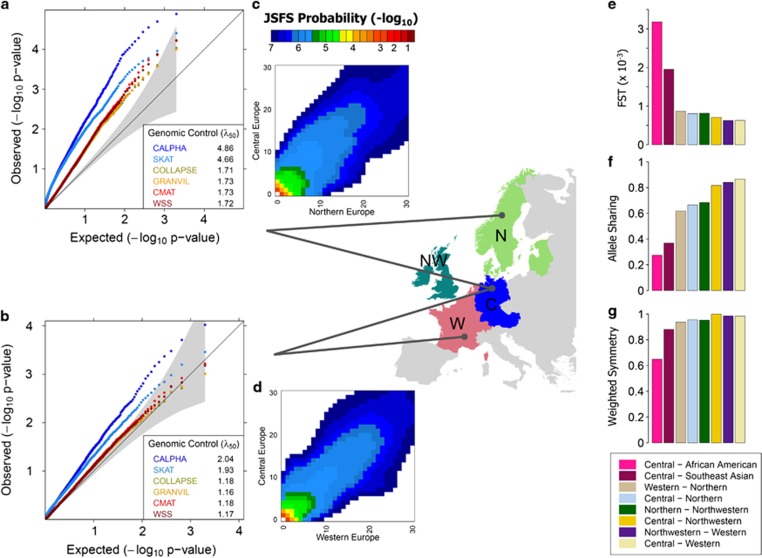Figure 1.
Rare variant diversity statistics and P-value distributions for gene-based tests in structured European populations. We focused on the empirical JSFS of rare, nonsynonymous variants in 202 drug target genes identified by sequencing of Northern, Northwestern, Western, and Central European population samples (labeled N, NW, W, and C, respectively, in map insert). Heatmaps of the JSFS, pictured for (c) Central and Northern European and (d) Central and Western European population comparisons, provide a graphical representation of the distribution of rare alleles between populations. We quantified aspects of between-population rare variant structure using: (e) the FST statistic of overall rare variant population divergence, (f) the allele sharing statistic to measure variation in population-specific frequencies of individual rare alleles, and (g) the weighted symmetry statistic to measure the evenness of cumulative rare variant load between the populations. To study the effect of these population structures on inflation in gene-based tests, we analyzed data sets simulated from each JSFS that contained population structure but no genotype-phenotype association. QQ plots provide the distribution of P-values for several gene-based rare variant tests in data sets containing a mix of (a) Central and Northern Europeans and (b) Central and Western Europeans. Genomic control values (λ50) quantify the inflation of the P-value distributions relative to a uniform null distribution. For illustrative purposes, we display the QQ plots for an extreme sampling scenario in which all cases are sampled from one population and all controls are sampled from the other population. Results for less extreme scenarios are shown in Figure 2. We find that data sets from more divergent populations (Central and Northern European) produce higher levels of P-value inflation for each gene-based test than data sets from more closely related populations (Central and Western Europeans). Furthermore, the joint tests SKAT and C-Alpha (blue dots in QQ plots) consistently show much higher inflation than the burden tests Collapsing, GRANVIL, CMAT, and WSS tests (red dots in QQ plots) across all population comparisons.

